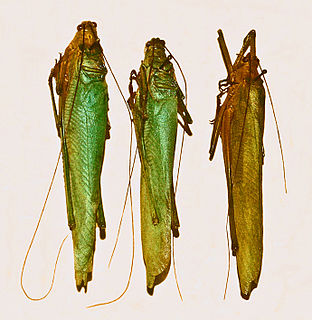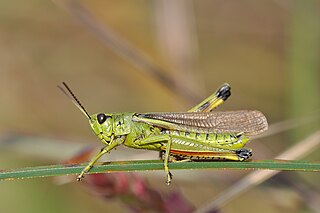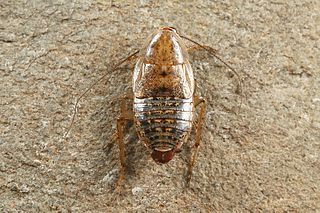
William Kirby was an English entomologist, an original member of the Linnean Society and a Fellow of the Royal Society, as well as a country rector, so that he was an eminent example of the "parson-naturalist". He is considered the "founder of entomology".

Gryllinae, or field crickets, are a subfamily of insects in the order Orthoptera and the family Gryllidae.

William Forsell Kirby was an English entomologist and folklorist.

Flower chafers are a group of scarab beetles, comprising the subfamily Cetoniinae. Many species are diurnal and visit flowers for pollen and nectar, or to browse on the petals. Some species also feed on fruit. The group is also called fruit and flower chafers, flower beetles and flower scarabs. There are around 4,000 species, many of them still undescribed.

Tetrigidae is an ancient family in the order Orthoptera, which also includes similar families such as crickets, grasshoppers, and their allies. Species within the Tetrigidae are variously called groundhoppers, pygmy grasshoppers, pygmy devils or "grouse locusts".
Kirby is a surname. Kirby is found in 116 governed bodies in the world, though is most concentrated in the USA (70,753), England (22,162), Australia (7,160), Canada (5,268), and Ireland (1,931) but most prevalent in Saint Vincent and the Grenadines (1:1,127). This shows the people with this surname have travelled and become residents in many nations around the world. It originated in Northern England or in Southwestern Ireland from the Old Norse word "kirkja" + "býr" meaning "church" + "settlement".

The Phaneropterinae, the sickle-bearing bush crickets or leaf katydids, are a subfamily of insects within the family Tettigoniidae. Nearly 2,060 species in 85 genera throughout the world are known. They are also known as false katydids or round-headed katydids.

Phaneroptera is an Old World genus of bush crickets in the family Tettigoniidae and is the type genus of the subfamily Phaneropterinae. It was described by Jean Guillaume Audinet-Serville in 1831.

The Christmas Island earwig is a species of earwig in the family Anisolabididae.

Ammophila is the type genus of the subfamily Ammophilinae of the hunting wasp family Sphecidae. Ammophila is a large and cosmopolitan genus, with over 200 species, mostly occurring in the warmer regions of all continents apart from Antarctica.
Megachile wfkirbyi is a species of bee in the family Megachilidae. It was described by W.F. Kirby in 1900, and renamed by Kohl in 1906.
Megachile paucipunctulata is a species of bee in the family Megachilidae. It was described by W. F. Kirby in 1900.

Zeuneria melanopeza is a species of katydids crickets in family Tettigoniidae subfamily Phaneropterinae.

Stenobothrus lineatus is usually called the stripe-winged grasshopper: it is a species of grasshoppers in the family Acrididae.

The large marsh grasshopper is a species of grasshopper belonging to the family Acrididae.

Ectobius pallidus, the tawny cockroach, is a species of non-cosmopolitan cockroach in the family Ectobiidae. It occurs in southern England, Belgium, France, the Netherlands, Germany, Switzerland, Italy, Spain and Portugal; in North Africa: Algeria and Tunisia. It is now known to be introduced into North America.

Capraiellus panzeri is a species of non-cosmopolitan cockroach in the subfamily Ectobiinae: commonly known by its original (genus) name Ectobius panzeri.

Ducetia is the type genus of the Ducetiini: a tribe of Asian bush crickets.

Pseudorhynchus is an Asian genus of bush crickets in the tribe Copiphorini, belonging to the 'conehead' subfamily Conocephalinae.
















